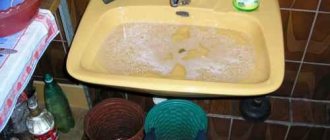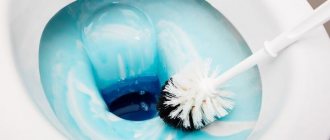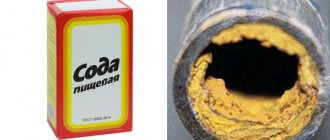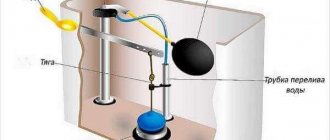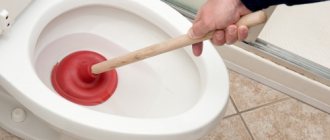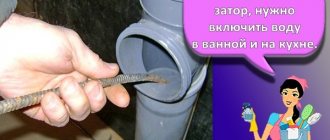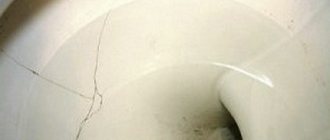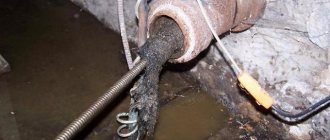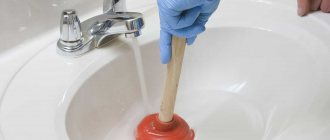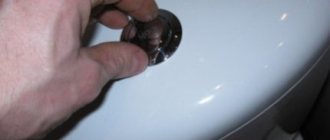Various contaminants can gradually form a clogged toilet. In apartments and private houses this can be:
- Hair and pet fur
- Hygiene products
- Toilet paper
- Small objects accidentally falling into the toilet
- Leftover food
- Mineral deposits due to poor water quality
Sometimes they are added to construction waste, silt, gravel, dead insects and rodents, pieces of matter and other objects that, according to all the laws of logic, could not end up in the sewer even hypothetically.
Helpful advice.
Use the toilet only for its intended purpose.
Throw leftover food into the trash can. For hygiene and cosmetic waste, keep a special container. Do not throw any objects into the toilet; if you drop something, pull it out immediately, wearing household gloves. All this will reduce the likelihood of complex blockages. All of the above gradually collapses into dense, heterogeneous lumps that literally plug the sewer drain and stagnation of water occurs in the toilet, and the drainage pipes may burst. What other reasons can lead to problems with the toilet? Where to go if the toilet is clogged and what to do if the water does not drain?
Types of blockages
All blockages can be divided according to the reasons for their occurrence and, accordingly, methods for eliminating them.
Toilet clogs are divided into the following types:
- Mechanical blockage - occurs during improper operation (dumping hygiene items and other large items). Such operation leads to the cessation of water flow.
- Technological blockage - forms when the sewer system wears out or is incorrectly designed (a huge number of bends, the use of pipes of different diameters)
- Operational blockage is considered the most common type and appears during the use of the toilet. Even if you follow all the known rules and use the toilet correctly, over time such a blockage can still form. It is formed subsequently by the deposition of fatty deposits on the walls of the pipes, to which various particles adhere.
There are reasons for sadness
Comrades, let's start by separating the flies from the cutlets. The causes of blockage can be very, very different, and depending on the diagnosis, we have to choose treatment.
So, what can clog a toilet?
It's funny, but in my memory, using it for its intended purpose has never led to problems . Their cause is always a violation of sewerage operating standards. More specifically?
Please:
- Toilet paper and paper towels. Yes, they get wet in water, but at the same time the paper noticeably increases in volume. If the toilet below the water surface is completely clogged with pipifax, an attempt to flush will quite predictably lead to aggravation of the situation;
The most common cause of a clog is a thick wad of toilet paper.
An even more unpleasant scenario is when newspapers or, even worse, glossy sheets of magazines are used instead of toilet paper. They are much denser and tightly block the outlet of the plumbing fixture.
- Fillers for cat litter boxes. Of all the types of filler, only one can be flushed into the toilet - made from pressed sawdust, and then in small portions. To pour clumping filler, lumps of silica gel or sand into the sewer and hope for the best is unforgivable naivety: the blockage will be inevitable, like the collapse of capitalism;
- Food waste. Your white friend is capable of absorbing a couple of liters of sour borscht, but disposing of moldy pickled tomatoes or spoiled porridge into it is a guaranteed way to get clogged;
- Floor rags. They have an unpleasant habit of floating away into the fragrant distance when you pour out the water after washing the floors. The rag can clog the toilet outlet or, much worse, get caught on a burr lower down the riser: then drains from all the upper floors will begin to flow into your toilet and bathtub;
After washing the floors, floor rags love to go on a solo swim.
- Construction garbage. If you pour pieces of plaster and small fragments of concrete or brick into the sewer, the result will be quite predictable;
- Finally, it is completely beyond good and evil to dispose of unused construction mixtures by pouring them down the drain. Hardening of concrete or mortar in a plumbing fixture usually means the end of its career.
To find out what caused the clog, interview family members about their last actions before the problem occurred. If the culprit does not want to sign a confession, you will have to scoop out the water standing in the toilet to inspect and localize the problem.
Cleaning the toilet correctly
It’s unpleasant to see a dirty toilet when entering the bathroom in the country. Besides, if he spreads an unpleasant smell throughout the room, then he is in it, there is no desire.
With a little effort (usually the procedure takes no more than 10-15 minutes), the toilet will regain its sparkling shine and get rid of the unpleasant odor.
Required Tools
- Ershik. At the moment, there are various configurations of the tool, but it is better to purchase models equipped with an additional nozzle for cleaning the toilet rim.
- Hard sponge. This tool is individual, and it is recommended to use it only in this case, periodically replacing it with new ones.
- Pumice. Ordinary foot cleaning products will not be useful in this case. Here you need a model equipped with a wooden handle or stick.
- Individual protection means. This set includes rubber gloves, a face mask and a special oilcloth apron.
Cleaning the inside of the toilet
The inside of the toilet is the dirtiest place and needs constant cleaning. And even despite the apparent cleanliness of the device, it needs periodic disinfection. For cleaning, liquid, powder or gel-like products can be used. Also, effective folk remedies are acceptable.
Cleaning plumbing inside:
- Remove water from the inside of the toilet. How to drain water from a toilet for cleaning? This is done in several ways: with a ladle or measuring cup, a technical syringe, or an empty shampoo bottle.
- Wear personal protective equipment.
- Use one of the selected cleaning products to fill the walls of the interior of the plumbing fixture.
- It is recommended to leave it in this state for at least a couple of hours.
- Taking a brush in your hands, thoroughly clean the surface. Do not forget that under the rim the main accumulation of bacteria and therefore this part of the toilet needs special attention.
- Drain the water from the tank.
- Re-treat the ceramic with a brush to remove any remaining cleaning agent.
- No foam should form after rinsing. In this case, we can assume that there are no traces of detergent left on the coating.
Cistern. Cleaning Rules
This is a place that also needs periodic cleaning - for example, once every 2 months. Stagnant water leaves a coating on the walls of the tank, thereby forming unpleasant odors and contributing to the destruction of connections of internal elements.
Let's start cleaning:
- We turn off the water.
- We flush the water from the tank.
- Remove the cover.
- Wearing gloves, apply the selected product to the walls of the tank.
- Rub it with a damp cloth and leave for half an hour.
At the final stage, it is necessary to draw and drain water several times. In this case, you can help with a rag, wiping the inside surface of the water container. Don't forget to close the lid and turn on the water supply.
Cleaning the outside of the toilet
The outer surface is easier to clean, but it is necessary to understand and know the secrets and rules of processing. In fact, the outer part is processed much faster than the rest. To do this, just take a damp cloth and wipe the entire surface. For disinfection, it is necessary to carry out treatment with a rag soaked in alcohol.
Seat cover
Do not neglect cleaning this element of the plumbing fixture. Since it has direct contact with the body, its treatment should be a priority.
Cleaning process:
- Remove the rim from the mountings.
- Get wet.
- Using a sponge and cleaning agent, scrub all parts of the rim.
- In the bathroom, under a strong stream, rinse off any remaining detergent.
- Using a dry cloth, wipe the entire surface of the lid.
Proper cleaning of the ceramic surface of the toilet will make it sparkle with cleanliness.
Tools
As you know, he who is forewarned is forearmed. However, information about the causes of blockages is not the only weapon we will have to use. To effectively deal with blockages, you need a small set of tools.
What tool is useful to have at home in case of blockages?
- Plunger. There is not the slightest need to spend money on a professional tool with a piston and pressure gauge: a regular rubber cap on a plastic or wooden handle for home use is no worse. A reasonable price for a plunger is no more than 200 rubles;
Cheap and cheerful.
- Plumbing cable. Its simplest version is a piece of steel sling with a handle made of a steel tube bent in the shape of the letter “Z”. Factory-made products with a plastic shell rotating relative to the handle and a cable made from a spring wound around a steel core are no different from it in practical terms.
A good tool with a reasonable price.
Cables with a drum are convenient because they can be used alone, without an assistant. However, such a product costs several times more than a regular plumbing cable. As a rule, they are bought by professionals: the device can significantly save your time only when clearing a large number of blockages during the day.
The product in the photo is intended for professionals. With rare home use, such a tool will not pay for itself.
If your nearest hardware stores don’t have the tools I listed, it doesn’t matter. As you will see later, you can often make do with improvised items instead.
How to independently determine the location of the traffic jam
To determine the location of the blockage, you should examine the sewer riser located in the kitchen and bathroom. It should be taken into account that the blockage can be common. And if you live in an apartment building, it may not be your fault at all. In a private house, if such a blockage occurs, the cause should be sought on the street, at the point where the pipe exits into the cesspool, or at the site where the local sewerage system joins the city sewerage system.
To determine the location of the blockage, you need to study the structure of the sewer system in your home.
The presence of a general blockage may be indicated by water that cannot be drained from the bathroom. If, when you turn on the kitchen and flush the toilet at the same time, the water flows well, the cause of the problem should be looked for in places of stagnation.
How is the sewage system arranged in apartments?
Sewage in modern apartments performs the task of removing human waste. For this purpose, a waste disposal line is installed from each point where waste is generated (toilet, sink and bathtub) to a common sewer riser.
Apartments located on adjacent floors are connected to it. The riser is a large pipe with a diameter of 0.1 m, located in the bathroom.
All sewer systems that are built in apartment buildings and private buildings must strictly comply with construction and sanitary standards.
Previously, only cast iron pipes were used for sewerage installations, but now mostly plastic ones are installed. In a plastic pipeline, the possibility of blockages is less likely, since defects do not appear on the walls, and “overgrowing” of the riser section occurs very rarely.
To make it easier to clean the riser in a high-rise, holes are made on each floor - sewer inspections.
The most often clogged cast iron pipes of the sewer system, which are found in older buildings. Overgrown pipes have increased resistance to runoff and are susceptible to external factors
The standard configuration of a plumbing fixture (toilet, washbasin or bathtub) looks quite simple:
- device drain hole;
- siphon (a curved elbow that is connected to the waste disposal line);
- supply pipeline to the riser;
- large pipe or riser.
The blockage can be observed in any area, but it should be borne in mind that the cause of its appearance is man-made. If the plumbing fixture is used for its intended purpose, there should be no problems.
Types and methods of cleaning a clogged toilet
Mechanical cleaning
Mechanical cleaning is carried out if there are small children or pets in the house. But it is not possible to block their access to the work site. Mechanical methods of removing the plug allow you to immediately clear the blockage from the pipe. You won't have to wait long.
How to clean a toilet with a plunger
How can you break through a toilet at home? The plunger should always be located next to the toilet. It makes it quite easy to deal with traffic jams. You can clear a small clog in the toilet by following these steps:
- the rubber part of the plunger is immersed in water; if there is not enough water, it must be added;
- the drain hole must be completely closed;
- The plunger is rhythmically pressed inward, then returned to its original position.
A plunger gradually removes clogged particles and cleans the pipes.
How and where to drill
For work, take a regular drill with a ceramic crown. A thick drill will not work; the plumbing may burst. How to: How to repair a hole or crack in an old iron barrel without welding
- find the water seal at the bottom of the toilet;
- mark the drilling point;
- carefully drill a hole;
- insert the hose fitting on two gaskets into the hole;
- attach the hose and secure it with wire.
Before cold weather, the hose is tightened with a clamp or wire, so it will not interfere with the operation of the toilet. With the onset of frost, the clamp is removed and the water is drained.
Chemical compositions for cleaning
If the cause of the blockage is the formation of limescale, you can try to soften it using any high-quality compounds intended for this:
Domestos: in addition to Domestos itself, the group of these fairly inexpensive and quite effective cleaning products also includes the Cif brand, produced by the same manufacturer;
- Domestos-gel
- Procter&Gamble: able to cope not only with plaque, but also with rust;
- Cillit: a widely advertised product is also quite suitable for cleaning even heavy deposits;
- Jonson&Jonson: used for cleaning hard-to-reach places, has packaging in the form of a “toilet duck” - a tube with a curved dispenser spout, which allows you to pour the composition along the rim of the toilet, simultaneously cleaning the accumulated plaque in this area;
- Tiret: a product for removing limescale deposits and preventing them;
- Sanita Gel: another high-quality product from a Russian manufacturer.
If you have already encountered the problem of clogs and know some other brands of products that can clear plaque from your plumbing, you can certainly use them. We have listed only the most well-known manufacturers whose products really work (unless, of course, you buy a fake).
Important!
Before using any composition, be sure to read the instructions. Most of these cleaners are designed for use in drains with cast iron or plastic pipes. Unfortunately, they can damage steel pipes.
Video: How to unclog a toilet yourself without difficulty at home
Features of home sewerage
Sewage is an integral part of the drainage and water supply system. It is designed to remove liquid and solid products of human activity, to purify household water from contaminants and return them for further use or into a reservoir. A sewerage system is necessary for comfortable living in a house or apartment.
Residents of apartment buildings are responsible for the condition of sewer pipes in the apartment, and owners of private properties must independently install local treatment facilities, remove sewage, and maintain pipelines and equipment.
In order to avoid unpleasant problems in the future, you should comply with the requirements of SNiP regulations on water drainage and sewerage. Then the system will work normally, without requiring constant monitoring or adjustment.
The internal sewer networks include:
- plumbing fixtures with water drainage;
- common riser which sewer pipes are connected;
- pipe layout that ensures the process of transporting wastewater from the drain hole to the riser.
Requirements for internal networks are specified in SNiP “Internal sewerage”, in GOST and SNiP “Sewerage”. The systems are installed inside the building and ensure the transportation of all wastewater from the place of its formation to the pipe exiting the building.
Basic requirements for internal networks:
- When installing plumbing fixtures on drains, a water seal is required.
- Cast iron or plastic pipes are used for laying networks.
- The diameter of the sewer system outlet from the house is at least 110 mm.
- When laying pipes, a slope of 2 to 2.5% must be maintained.
The internal networks of the sewer system must be equipped with ventilation. The process of ventilating the networks is carried out through common sewer risers - an exhaust part is installed, leading to the roof.
Due to the resulting blockages, normal drainage of wastewater becomes impossible, so it is necessary to immediately resume the full functioning of the sewer system. In order to avoid unpleasant consequences due to a blockage in the pipeline, you need to call specialists or clean the sewer yourself.
Cleaning the toilet with folk remedies - soda, vinegar, boiling water or mustard
When a problem arises, the first thought that appears in the minds of residents is “What should you do if the toilet is clogged?” It is advisable to destroy the cork as quickly as possible, which is why many people use folk remedies first.
There are many similar methods, but the most common is the use of soda, vinegar, boiling water and mustard.
- Boil 1 bucket of water.
- Pour liquid into the drain at a 90-degree angle. This must be done very quickly.
- If the method works and the liquid gradually disappears, it is recommended to repeat the previous steps 2-3 more times.
The next option is to use baking soda. This substance belongs to the category of alkalis, so it can rid the pipeline of small plugs. Instructions:
- Prepare half a pack of regular baking soda.
- Pour the substance into the drain hole.
- Wait 3-5 minutes.
- Drain the water.
Thanks to boiling water and soda, it is possible to get rid of simple blockages.
The next method is more effective because combines the previous ones. For this you will need to prepare baking soda, boiling water and 9% acetic acid. Algorithm of actions:
- Remove water from the toilet, leaving only a small amount in the drain hole.
- Pour 0.5 packs of soda into the drain as deep as possible.
- Pour a glass of acetic acid.
- Wait 20 minutes.
- Pour boiling water.
As a variation of this method, the following scheme can be used:
- Pour half a pack of baking soda into the drain hole.
- Pour concentrated acetic acid inside (the entire bottle).
- Close the drain.
- Leave for 2 hours.
- Pour hot liquid.
- Wait until the dirt and small debris dissolve, if this is what caused the blockage.
It is important to note that it is not always possible to remove blockages using boiling water. If the sewer connection design uses a connecting corrugated pipe made of thin plastic, you cannot pour boiling water.
In such a situation, it is better to use hot (but not boiling) water. You should also be as careful as possible when using vinegar.
You can use salt instead of acetic acid:
- Mix 1 cup salt and 1 cup baking soda.
- Pour the resulting substance into the toilet.
- Pour 1 liter of boiling water.
- Leave for 7-9 hours.
It is best to do this method at night. By morning, the resulting blockage should dissolve.
Another popular method for clearing clogs is using mustard. Instructions:
- Heat 10 liters of water to 80-90 degrees.
- Add 5 teaspoons of mustard to the water. If a different volume of liquid was heated, then the ratio should be used: for 2 liters of water - 1 tsp. mustard.
- Pour the solution into the toilet.
- Wait 2-5 minutes.
- Rinse off.
- If necessary, carry out this procedure a couple more times.
Sometimes, in search of an answer to the question “What to do if the toilet is clogged?” The homeowners decide to use Pepsi-Cola or Fairy detergent.
However, Pepsi-Cola can only be useful for removing deposits from plumbing fixtures, and this substance is not capable of cleaning drains.
Fairy detergent can only help when the clog in the toilet is caused by a large layer of fat (this is often the case with clogs in the kitchen sink). Then you can pour half a bottle of detergent down the drain.
But in most cases, in the fecal sewer system, the use of “Fairy” will not bring the desired result.
It is important to remember that such methods can only help with small traffic jams. For more serious problems, it is recommended to contact a plumber who will use mechanical cleaning methods.
What not to do during a traffic jam
We've sorted out what to do if the toilet is clogged. Here are some tips on what exactly you shouldn’t do, so as not to aggravate the situation.
- Pour Coca-Cola down the toilet. On the Internet you can find many life hacks about this, but it is better not to check the magical properties of this drink and buy professional chemistry.
- Use cleaning products. Whitening or dishwashing detergent will not help the situation. They are not able to break down even small debris.
- Try to clear the blockage by draining the tank. If the blockage is serious, water will flow out. Don't experiment.
The toilet is clogged - cleaning it with a “doll”
A fairly common and effective method is the use of a “doll”.
This device is a fabric bag that is filled with sand and has a long rope. How to remove a blockage in the toilet using a “doll”:
- Make a device.
- Lower the bag into the drain hole, holding it by the rope.
- Drain the water in the tank. This will lead to the fact that the “doll” will go with the flow of water and with its mass will be able to break through the plug that appears.
- When the water goes away, you need to carefully pull the rope and remove the bag from the drain.
When making a “doll”, it is recommended to use a fairly long and strong rope. Using old rope can cause the bag to tear off, causing the drain line to become completely clogged.
How to drain the toilet for the winter
You may need to install or replace a toilet under a variety of circumstances: moving, renovation, or unexpected breakdown. If you don’t have time to wait for a plumber or want to save money, then it’s quite possible to do it yourself.
Preparing your cottage for winter - 15 important things you might have forgotten about
In order not to end up with nothing at the beginning of the next season, you need to properly close the current season. It's time to carry out work that will help preserve the suburban area until spring. So, we’ll tell you how to prepare your dacha for winter.
Surely, you have already started to complete the bulk of your work. We have no doubts about your dacha experience, and, nevertheless, we suggest you check - what if something “went over your head”?
Clogged toilet - fix with film
There is also a method that is not very well known, but is quite effective for clearing a blockage in the toilet that has arisen as a result of debris or various objects getting inside. For implementation, you only need wide tape or cling film.
How to clean a drain using tape:
- The toilet bowl must be thoroughly wiped clean of liquid.
- Carefully begin gluing lines of tape onto the circle, connecting the strips to each other. As a result, a dense, sealed film with no cracks should form on the toilet circle.
- Rinse the water in the tank.
- Press the film firmly several times to remove the blockage.
- When the desired result is achieved, remove the tape.
There is a special film for these purposes, so it is better to use it if possible. However, sometimes it is quite difficult to find film, so you can replace it with tape. The procedure will take more time, but this method is as effective as using specialized material.
Hangers
One effective homemade device for cleaning clogged toilets is a regular wire hanger. In order to break through the blockage, perform the following steps:
- Straighten the structure with pliers. Leave a hook. It will serve as a handle.
- A rag is tied to the other end of the hanger and secured well so that it does not fly off when cleaning. It will protect the toilet bowl and pipes from damage.
- 60 ml of any dishwashing liquid is poured into the toilet. Wait 5 minutes until the product flows to the clog and lubricates it, which will facilitate the cleaning process. Shampoos and gels are used for the same purpose.
- Rubber gloves are put on your hands. The end of the hanger, wrapped in a rag, is inserted into the toilet. Push it down the drain until it clogs.
- The cork is pierced by making a back-and-forth motion with the hanger.
Several options for improving a country street toilet
A simple “house of thoughtfulness” with a drafty roof and doors is an atavism. Today, many summer residents build quite comfortable toilets with a toilet, water drain, and washbasin.
When equipping the facility, sewerage pipes are additionally installed. The tie-in is organized into the highway of the house. With the right choice of pipes and connectors, the costs will not be high and the work will not be complicated. For the winter, the structure is dismantled or preserved by draining water.
If there is a drainage system, it is not a hose that is placed in the hole in the toilet water seal, but a thin tube, the end of which is lowered into the sewer outlet pipe. The tube is not pinched; it drains excess water continuously, which prevents the development of bacteria inside the water seal. In this case, the process of cleaning the toilet takes less time.
How to Clear a Toilet Paper Clog Using Baking Soda
You can remove operational blockages using regular baking soda, which in most cases is available to every housewife.
- Dissolve half a pack of soda in warm water.
- Pour into the toilet drain hole.
- After 2 hours, rinse the toilet with water.
There is a more effective way using baking soda. Since the soda solution is alkaline, if you heat it in a frying pan, it will become more active and will be better able to cope with the blockage. For this you will need:
- 150 g of baking soda (about 5 heaped tablespoons);
- 200 ml water;
- pan.
Step-by-step instruction:
- Pour baking soda into a frying pan and heat over low heat for 15 minutes, stirring continuously. By the end of the process, the release of carbon dioxide should stop, and the soda will become more flowable.
- Remove the pan from the heat and let cool for 10 minutes. This is a prerequisite necessary to prevent burns when the substance is combined with water.
- Pour the resulting powder into a working container and add 200 ml of water to it. Mix well. The sodium carbonate should either completely dissolve in the water or leave a small residue.
- Pour the resulting light brown solution into the toilet drain hole.
- After 2 hours, rinse the toilet with plenty of water.
Baking soda is an effective toilet cleaner
Check the well
The well does not require special preparation for winter. But if the water has acquired an unpleasant odor of hydrogen sulfide (the smell of rotten eggs) or a cloudy sediment, cleaning and disinfection measures must be taken. You can probably handle a small well (2-3 rings) on your own. Using a drainage or pump pump, pump out the water, go down into the well, and clean the walls of dirt. Then disinfect the well.
To disinfect a well, you can use tablets designed to purify pool water. They are dissolved in a bucket of water (1 tablet per 1 well ring), then the mixture is poured into a well filled with water and left for 6-8 hours. After this, the water is pumped out again.
If you clean the well in the fall, it will not be necessary to do this in the spring - regular disinfection is sufficient.
How to clean a toilet without a plunger
The plunger is an inexpensive, universal, effective tool that takes up little space and is not particularly difficult to use. To achieve maximum results when deciding how to clean a toilet at home, you need to choose the right diameter of the flexible part. It should be 1-2 cm larger than the size of the toilet drain hole.
If there is no factory-made plunger, then it is quite possible to make a similar item to solve the problem of how to remove a clog in the toilet. For this purpose, use a 1.5-2 liter plastic bottle, the bottom of which must be cut off as evenly as possible and the lid screwed on tightly. The bottle should be inserted into the toilet drain and made several vertical sharp movements. Professionals note that such a product can give a greater effect than a factory plunger. According to experts, a plastic bottle creates quite a lot of hydraulic pressure.
If the blockage is caused by a foreign object, and it can be observed visually, then there is no need to take action to push the object further into the drain. In this case, to solve the problem of how to clear a clog in the toilet, you need to try to remove this item from the toilet, putting on rubber gloves of the required length or a regular plastic bag.
In addition, if you don’t have a plunger, you can try to clear the blockage in the toilet at home using a flexible polymer or rubber hose. Using this option allows you to avoid damage to plumbing and pipes, and also makes it possible to penetrate 1.5-2 meters inside the drain. By performing rotational movements with the hose, you can push it through places e. The work is done with rubber gloves; they protect your hands from contamination and damage, and provide a more secure hold of the hose.
Another option for solving the issue of a clogged toilet, how to unclog it without a plunger, is to use a small bag filled with sand. It should be noted that it is not recommended to use nuts, stones or other hard materials for weighting as filler. They can damage the body of the plumbing equipment. The bag with the filling is tied to a rope and immersed in the drain. Next, perform several shock movements and drain the water. In this way, you can eliminate minor blockages at a great distance from the drain hole.
Mechanical cleaning
A plunger is useful for mechanical cleaning.
It is used if a blockage has formed somewhere in the lounger, and water is standing not only in the toilet, but also in other appliances. The plunger is operated through the drain hole of a sink or bathtub, that is, a plumbing fixture with a flat bottom, which must be partially filled in order for the plunger to pump water.
At the same time, drain holes in other appliances are covered with rags.
Using a plastic bottle
Installing a plunger in the toilet will not work. So if there is a blockage in the outlet or connecting collar, that is, before connecting to the bed, this tool is useless. In this case, a homemade plunger made from a plastic bottle will help.
A model plunger from a plastic bottle is made simply:
- cut off the bottom of a 1.5-liter plastic bottle;
- screw the cap tightly onto the neck.
Lower the device with the cut part into the drain hole filled with water and quickly move it up and down.
When moving down, the air cushion in the bottle presses on the water and this pressure is transmitted in the form of a water hammer to the point of blockage. Eventually, it will be broken by the rocking movements and the water will begin to drain away.
Film plunger
The South Korean company Pongtu produces a special reinforced film that functions like a plunger.
The device works like this:
- the toilet is filled with water;
- The top of the device is sealed with film;
- the master presses rhythmically on the film.
Pongtu supplies 2 disposable films in one package.
The advantage of this solution compared to a plunger from a bottle is the absence of splashes. Instead of Pongtu film, you can use wide tape. The strips are glued overlapping and in several layers, so that a tightly stretched film is formed. Its edges, glued to the side of the toilet, are additionally wrapped with another tape.
Cable and “doll”
Professionals usually use a plumbing cable with a tip on one side and a curved handle on the other. Two people work: one rotates the handle, the second feeds the tool into the sewer. Rotation is necessary for the cable to pass knees and turns.
From time to time the cable is moved back and forth to loosen the blockage. After cleaning, pull it out little by little, wiping it with a wet rag. If you don't wipe it down, everything the cable touches will get very dirty. Next, the sewer is washed with hot water with the addition of technical soda.
If there is no plumbing cable, it is replaced with an electrical cable with sufficient rigidity. To clean plastic sewers, you cannot use a cable without a tip or with sharp ends of wire sticking out to the sides: such a tool will scratch the pipes from the inside and they will become overgrown with dirt.
Special care is also required when passing the corrugation: it is easy to break through. Another famous instrument is the “doll”.
This is what plumbers call a homemade punch for mechanical drain cleaning. It is a fabric bag tightly filled with sand (an old sock will do) attached to the end of a long piece of thick wire.
Having disconnected the toilet from the sewer, push the “doll” into the pipe and use it to push the clog towards the riser.
When do you need a plumber
If you cannot break through the toilet using available means, all methods and means of clearing blockages have not brought results, you need to think about calling specialists. They can inspect the plumbing and determine whether it is necessary to try to restore normal functioning or install new equipment.
This is especially true when the plumbing equipment is old, the drain hole in it is overgrown with a layer of urinary stone by about 15 mm. The plumber will quickly remove a massive dirt plug or remove the stuck object.
Types of pollution
The main problem that people face in their bathrooms and toilets is the yellowness of the plumbing and its sloppy appearance. It also forms unsightly stains of dirt, a crust of limescale, traces of corrosion and biological contaminants.
Don’t stop cleaning regularly and don’t leave your plumbing in a state of disrepair, otherwise you will have to work very hard to get rid of many problems. Sometimes you just have to throw away your plumbing fixtures.
Long-term use of the toilet entails the formation of limescale and urinary stones, which are extremely difficult to remove. Therefore, in the arsenal of the fight against urinary stones, you should always keep several effective ways to remove such contaminants.
Preventing clogging
In order to prevent the toilet from clogging, or to delay such a problem, it is necessary to use it only for its intended purpose and minimize the entry of foreign objects into it.
- In the event that something gets into your toilet, it is best to remove everything unnecessary from it immediately.
- Many people prefer to pour dirty water into the toilet after washing the floors; this is absolutely not worth doing, or it is recommended to use special filters that prevent the penetration of debris.
- If there are small children living in the house , then it is best to carefully ensure that they do not throw their toys into the toilet, and also try to explain to the child in as much detail as possible why this is not required. From an early age, it is necessary to teach a child how to use the toilet correctly and for its intended purpose.
- Another condition for preventing a clogged toilet is that you should never pour greasy water into it, as fat accumulates on the bends and over time forms a clog that will be very difficult to remove.
- Some housewives make one of the most serious mistakes, leading to irreparable consequences. They throw leftover food down the toilet. This applies not only to solid waste, but also to liquid treats.
- If renovations are planned in a house or apartment , then in order to prevent construction debris from entering, it is best to carefully cover the toilet. This will also prevent dust from getting inside.
- In the case of preventing blockages in an apartment building, all issues must be resolved without fail and prevention must be systematically carried out, which must be monitored not only by the residents, but also by the management company.
Important! It is recommended to systematically use specialized products to prevent blockages. They are sold in all household stores. When purchasing such a product, you should check that “prevention” is written on the label. This product must be used only strictly according to the attached instructions.
In addition to professional means for preventing blockages in the toilet, more accessible and inexpensive options are used, the components are available to almost any housewife. For example, soda, which is diluted with hot water and poured into the toilet approximately once every two weeks.
The cause of a blockage is not always grease or the ingress of foreign objects, since sewer pipes wear out sooner or later, and the resulting rust causes the blockage. In this case, only a complete replacement of the sewer will help, otherwise eliminating the blockage will be repeated systematically.
Despite the fact that, after reading this article, everyone became familiar with methods for removing any blockage, you should not let your toilet get to this point. After all, it is much easier to prevent than to eliminate, so save your strength and nerves by using the toilet for its intended purpose, as well as taking the necessary preventive measures.
What can I use to wash it?
Domestos or Toilet Duck can easily and quickly deal with ordinary stains only if they are used regularly. To avoid the appearance of traces of urinary stones, you should clean the toilet bowl from yellow plaque with your own hands at least once every seven days.
Take care of your toilet and wipe the plumbing with a washcloth and a special detergent or regular washing powder.
We list several available options:
- Regular vinegar will help clean the toilet . It must be poured into water and left for about 3 hours. After this you just need to press the drain button. This simple and affordable method will allow you to get rid of minor accumulation of urinary stones after the first use.
- Citric acid is another component that allows you to remove urinary stones and limescale without wasting money and time. Two bags of citric acid are poured into the toilet and left there for 3-5 hours. After which the product is washed off with water, and the remaining plaque is removed with a brush. If after the first cleaning the expected result is not achieved, you should repeat this simple procedure.
- “Whiteness” is far from a harmless remedy, however, it is quite effective in the fight against urinary stones. Use a plunger to remove all the water from the toilet elbow, after which a bottle of “Belizna” is poured out, the toilet is closed with a lid and left overnight. In the morning, you need to wash off the product several times and evaluate the result. If desired or if the result is unsatisfactory, repeat the procedure again.
- A 33% saline solution is used when cleaning a toilet only if the plumbing fixtures are not made of plastic. Removing urinary stones using acid should only be done while wearing protective gloves, thereby protecting the skin from possible chemical burns. Pour acid generously over the dry walls of the toilet and then leave for half an hour. Before rinsing, clean the stained areas with an unnecessary brush and rinse several times with clean water. The method, although quite toxic, is extremely effective.
- Electrolyte is another method that is prohibited if you have plastic pipes. However, electrolyte is the most radical and effective in methods of cleaning the toilet from urinary stones. The electrolyte is simply poured into the toilet, left there for a couple of hours and washed off with water.
- Perhaps in every home you can find oxygen bleach , which can also be useful in getting rid of urinary stones. The product is poured onto the urinary stone, then the area is intensively rubbed with a hard brush and washed with clean warm water.
- Abrasive cleaning products such as Domestos, Komet. The method of using them is simple, although unpleasant. All the water is scooped out of the toilet, the walls are covered with the product and rubbed with a rag or sponge until crystal white. The only disadvantage of this method is that the glossy surface of the toilet may become rough due to the formation of scratches after cleaning with such means. And scratches, in turn, contribute to the rapid accumulation of plaque and urinary stone on the walls of the toilet.
- Dry oxalic acid is used more often in the chemical industry to clean the surface before applying an enamel coating. But a small amount of such acid can successfully remove dirt from the toilet. To do this, the substance is applied to a rag (the use of gloves is mandatory), with which the dirty areas are wiped. Even simpler is to pour the acid into water, clean it with a brush and rinse with water.
- Carbonated drinks such as Cola, Sprite. Although the purpose of these drinks does not at all imply cleaning toilets, as practice has shown, they cope with this task quite well. Only after this does one become afraid of what these drinks can do to a person’s stomach. A couple bottles of sparkling water are poured down the toilet. Due to the citric acid content in the drink, plaque is corroded extremely quickly.
It must be remembered that a new and expensive toilet is much easier and more profitable to keep clean. We must not forget about preventative agents that can clean the drain from all kinds of plaque and deposits.
There is no need to pour and throw leftover food and garbage into the toilet, thereby shortening the service life of both the drainage system and the operation of the toilet in general, and sometimes this can even lead to a blockage in the general sewer system.
What you shouldn't flush down the toilet
Nothing other than ordinary toilet paper, which quickly decomposes, should be flushed into the central sewer system. The rest may clog it.
Tampons, pieces of even very thin cellophane should not be thrown into the toilet at all.
Fat remaining in a frying pan after cooking should not be washed down the drain. It is carefully wiped with paper and thrown into the trash.
Tea leaves can also form the basis of a cork. It is not always possible to remove clogs in the toilet and deposits on the walls of pipes at home. Therefore, you need to be careful.
